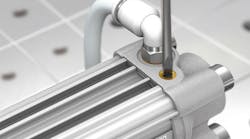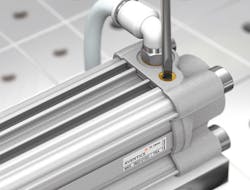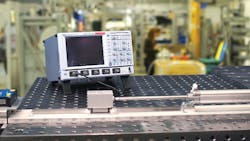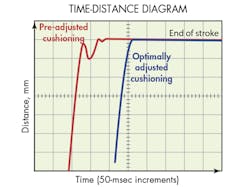This file type includes high resolution graphics and schematics when applicable.
Productivity, energy efficiency, and long service life are three key requirements when specifying pneumatic components for automation systems. Cushioning is one (perhaps underappreciated) way to improve overall pneumatic performance and help meet these goals.
Cushioning of pneumatic-cylinder motion is essential in machines ranging from packaging equipment to sawmill trimmers—in essence, in any application that sees sizable loads and fast speeds. Cushioning prevents a cylinder piston from impacting the cylinder endcap or base at uncontrolled speeds. Uncushioned cylinders can strain and damage the products being moved; shorten the life of seals, bearings, and mountings; and generate vibrations throughout an entire machine. Furthermore, they generate excessive noise.
Cushioning reduces the piston speed of a cylinder in a controlled manner before it reaches the end position. Pneumatic-cylinder manufacturers generally employ three techniques for cushioning: simple mechanical shock absorption using devices such as elastomeric bumpers; adding external shock absorbers; or pneumatic cushioning. External shock absorbers are the most expensive method, and they also require more space than the other two options. Mechanical cushioning absorbs impact energy only to a limited extent.
Pneumatic cushioning is the most sophisticated and efficient option for most applications. As an air cylinder traverses through a stroke, it maintains a constant velocity by controlling exhaust flow out of the cylinder. But as the cylinder nears its end of stroke, the piston enters the cushion seal, which eliminates the free-flowing exhaust path. The remaining controlled air volume decreases and the gas compresses. Exhaust air meters out through the cushion in a controlled fashion to produce the desired deceleration.
With optimally adjusted pneumatic cushioning, OEMs and system integrators can significantly shorten machine cycle times and, as a result, increase productivity. At the same time, they often lower air consumption—sometimes by more than half—compared with cylinders with nonpneumatic cushioning.
Pre-Adjusted Cushioning
When it comes to pneumatic cushioning, engineers can choose from pre-adjusted and adjustable variants. A current trend in automation is to simplify engineering, and to do that an increasing number of automation-system manufacturers offer pre-engineered subsystems and modules. One such example is pre-adjusted cushioning for pneumatic cylinders. But while the use of pre-adjusted cushions may simplify set-up and commissioning, it also can hurt productivity and energy efficiency. Here’s why.
Pre-adjusted cushioning uses an average damping value. Exhaust flow, or venting, from the cushion is fixed and cannot be changed. That’s fine if the cushion is properly specified in an application where loads or speeds are known and don’t vary. But often, pre-adjusted cushioning only covers a limited range of the possible cushioning capacity, and users are forced to compromise when it comes to dynamics and precision.
If moving masses are too small or speeds too low, over-cushioning results. The piston rebounds before reaching the end position and causes vibrations, due to the excessive air cushion. This results in slower cycle times, and the end-of-stroke position sensor may accidentally switch. In the worst-case scenario, triggering the switch too soon prematurely initiates the next step in an automation process sequence, potentially leading to a machine control malfunction.
On the other hand, if masses are too large or speeds too high, under-cushioning results. The insufficient air cushion causes the piston to hit the end position with excessive force, possibly damaging the cylinder, supports, and machine. Vibrations also result, which lower the system’s service life and increase noise levels. In this case, the user must specify a larger cylinder with higher cushioning capacity to sufficiently dampen motion for the mass or speed. This, however, increases procurement and operating costs.
This file type includes high resolution graphics and schematics when applicable.
Adjustable Cushions
This file type includes high resolution graphics and schematics when applicable.
In contrast, adjustable cushioning helps optimize pneumatic cylinder performance during set-up and when loads or speeds change. Adjustments are made via a simple adjusting screw, which changes the cross-section and flow through the cushion’s exhaust port. Usually, a screwdriver is all that is needed for proper cushioning adjustment—although cushions must be adjusted both for cylinder extension and retraction.
For example, with adjustable cushioning in the current generation of Aventics ISO pneumatic cylinders, only a few turns of the screw are sufficient to adjust the cushioning to the workpiece weight and movement dynamics. The results can be dramatic. Optimally adjusted cushioning can shorten braking time by up to 75% compared with pre-adjusted systems. This, in turn, means significantly shorter cycle times and higher productivity.
Consider, for instance, a 7-kg workpiece being moved at 1 m/sec. For a cylinder with a 32-mm piston diameter and a 250-mm stroke, pre-adjusted pneumatic cushioning requires approximately 80 msec to brake. Compare that with a cylinder with precisely adjusted cushioning and brakes in only around 20 msec. This change reduces cycle time by 75%. In typical applications, engineers can readily improve cycle times and productivity by up to 40%.
In addition, proper cushioning can have an important bearing on energy efficiency. Pneumatic cushioning capacity is the basis for sizing a pneumatic cylinder. Depending on the application, properly adjusted cushioning lets pneumatics users specify cylinders up to three sizes smaller than those with pre-adjusted cushioning, significantly lowering air consumption in many applications.
In the above example, a 16-mm diameter cylinder with adjustable cushioning can replace a pre-adjusted cylinder with a 32-mm diameter without affecting performance. Using a smaller cylinder alone reduces air consumption by 53%. In addition, users can opt for smaller valves and tubing to generate even higher energy savings, depending on the application.
Based on tests with higher loads, a general rule of thumb is that the more powerful the application, the greater the potential savings. And the benefits are widespread. In addition to users saving on energy costs, machine manufacturers save on procurement costs for cylinders, valves, conductors, connectors, and other related components. Minimizing energy consumption even lowers a user’s carbon footprint.
Ideal Cushioning
As good as adjustable cushions are in terms improving productivity, performance, and energy efficiency, on their own they’re not perfect. Manual adjustment of cushions involves judgment and skill by the engineer or technician to get the settings just right.
In some cases, a unique adjustment system termed ideal cushioning works even better. Ideal cushioning, a specialized pneumatic tuning process developed by Aventics, Lexington, Ky., takes cushion adjustments one step further.
Ideal cushioning is a method of decelerating a pneumatic cylinder piston as it reaches the end of its stroke. Essentially, it completely eliminates end-of-stroke bounce and end-cap slamming, which are the main culprits of cylinder damage, wear, and noise. Note that cylinders capable of achieving ideal cushioning have both precision cushion adjustment and elastic cushioning rings.
In practice, a cylinder operates with maximum piston velocity throughout nearly its entire stroke. Then, it quickly decelerates and its velocity drops to exactly zero just when it reaches the end cap. Reducing piston velocity to zero at the end of travel means the cylinder incurs less stress. Vibration in the host structure is reduced and total cycle time improves, sometimes permitting a boost in machine speed by as much as 30%. In addition, noise from the piston striking the cylinder’s end cap is negligible.
Calculating the amount of cushioning needed is straightforward. An electronic meter, such as an Aventics velocity-time meter (VTM), lets users monitor piston speed and cycle times. In the past, piston velocity was difficult to detect and measure and, thus, was done by guesswork or “eyeballing.” This electronic aid, which attaches to the outside of the cylinder tube, lets engineers and technicians quickly and easily determine the true velocity of the piston.
Then, much like the adjustable cushions discussed previously, ideal cushioning adjustments are made with a simple screwdriver, permitting a free outlet flow adjusted so the piston stops right at the end cap with zero speed. In machines with banks of cylinders, pistons are adjusted one at a time, with the first one used as a standard to conform to a maximum speed for a given pressure and cylinder load.
The end result: By controlling a high-speed mass moving at a consistent speed, and eliminating the noncushioned piston lag and bounce, the machine’s control can be adjusted to reduce the usual program lags—thereby tightening the entire operation and increasing throughput.
Ideal cushioning is particularly important on equipment that sees fast process cycles and high kinetic energy levels. Cylinders set up using this technique can accelerate high loads while eliminating excess piston movement and bounce. With ideal cushioning, users can increase speed and production while lessening noise and downtime. In addition, less wear-and-tear on cylinders reduces maintenance requirements and the cost of replacement parts.
John Bridges is marketing manager for Aventics, Lexington, Ky.
This file type includes high resolution graphics and schematics when applicable.






